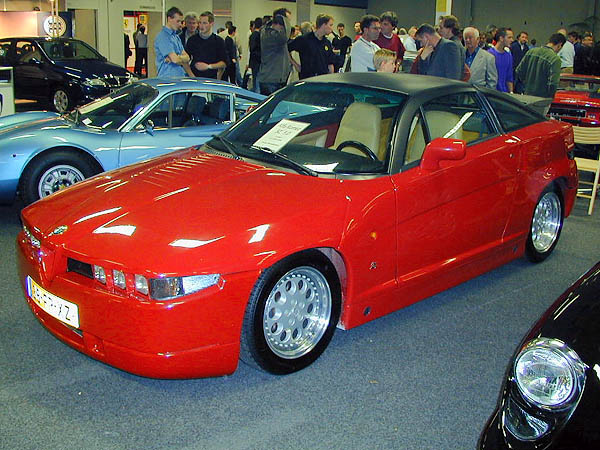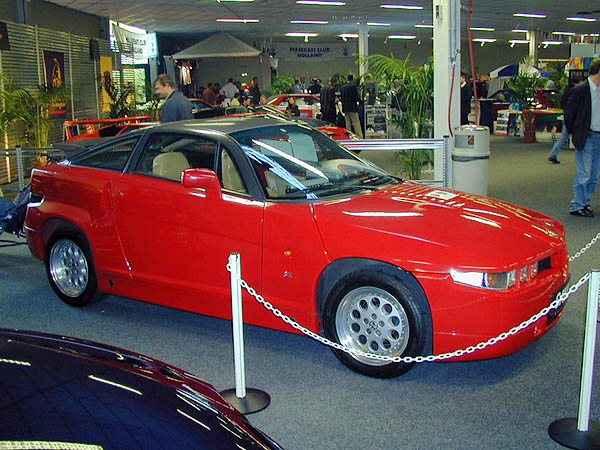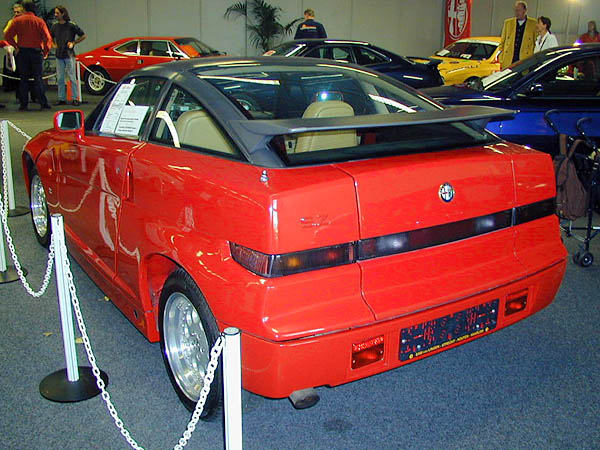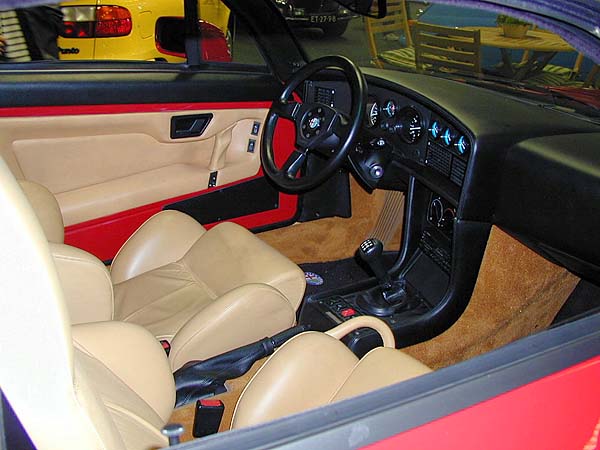|
The relation between Alfa Romeo and
Zagato dates back to well before the second World War when the company
of Ugo Zagato supplied bodywork for racing cars like the 1929 Alfa Romeo
6C 1750 Gran Sport. In the 1950s Zagato specialized in lightweight Gran Turismo bodies for a wide range of sports cars. Alfa Romeo had a hard time reviving the company after WW II but finally made it to successful mass production with the small but lively Giulietta models. To give the regular berlina (sedan) models an appealing image its introduction was preluded by the 1954 Giulietta Sprint Veloce (SV), an elegant and sporty
coupe.
For use in GT competition racing some Giulietta SV cars were rebodied by
Zagato, and these were considerably more successful than the factory cars
because of the efficient design and a reduction in body weight by some
110 kg. This Giulietta SVZ became almost a class of its own in GT
racing, so much so that Alfa Romeo decided to adopt the design. And this
way the illustrious Alfa
Romeo Giulietta Sprint Zagato (SZ) appeared in 1959, which went on
to accumulate numerous victories in road and track races.
In 1963 the by now famous Giulietta SZ was replaced by the larger and
exotic Giulia
Tubulare Zagato (TZ) models, again a much coveted line of thoroughbred competition sports cars produced up to 1967. For regular road use the Alfa Romeo 2600 Sprint Zagato was introduced in 1962 and offered
from 1965 to 1967. This model can, in a way, be regarded as the ancestor of the new Alfa Romeo SZ.
 But this family line only reflects on the historic Alfa-Zagato combination and the name of the car, which was first shown in 1989 as the ES-30. This "Experimental Sportscar-3.0 litre" was unveiled at the Geneva Motor Show as a prototype by Zagato, but in fact its design history was far more complicated. No less than 3 teams were asked to design a proposal: the studio of Zagato, Alfa Romeo's own Centro Stile (Walter da Silva and Alberto Bertelli) and Fiat's design center headed by Robert Opron, the distinguished French designer of the CitroŽn CX for example. Unfortunately for Zagato its original design was discarded early on and ultimately the design which originated from the Fiat design center lead to the ES-30, with Robert Opron making the initial drafts and young designer Antonio Castellana largely responsible for both the styling of the body and the interior of the car. But this family line only reflects on the historic Alfa-Zagato combination and the name of the car, which was first shown in 1989 as the ES-30. This "Experimental Sportscar-3.0 litre" was unveiled at the Geneva Motor Show as a prototype by Zagato, but in fact its design history was far more complicated. No less than 3 teams were asked to design a proposal: the studio of Zagato, Alfa Romeo's own Centro Stile (Walter da Silva and Alberto Bertelli) and Fiat's design center headed by Robert Opron, the distinguished French designer of the CitroŽn CX for example. Unfortunately for Zagato its original design was discarded early on and ultimately the design which originated from the Fiat design center lead to the ES-30, with Robert Opron making the initial drafts and young designer Antonio Castellana largely responsible for both the styling of the body and the interior of the car.
Apparently Zagato only made small contributions to the design of the front and the rear of the ES-30, but still the illustrious "Z" crest of Zagato would grace the sides of the car. General opinions on the almost extra terrestrial looking ES-30 were encouraging enough for Alfa Romeo to start up a production line for a limited series of this car, now renamed into SZ (Sprint Zagato) as a reminder to Alfa's inspiring past.
 The first 11 SZ cars were made that same year and a maximum production number of only 1,000 was announced. In 1990 the distribution of the SZ got under way with 289 cars produced. 1991 was to be last production year for the SZ. The final 736 cars left the factory, making the grand total for the SZ 1,036 produced cars (of which 38 were prototype and pre-production cars destined to be scrapped, but some of them are still extant). The first 11 SZ cars were made that same year and a maximum production number of only 1,000 was announced. In 1990 the distribution of the SZ got under way with 289 cars produced. 1991 was to be last production year for the SZ. The final 736 cars left the factory, making the grand total for the SZ 1,036 produced cars (of which 38 were prototype and pre-production cars destined to be scrapped, but some of them are still extant).
There was only one color scheme available for the SZ: a red body ("Rosso Alfa") combined with a dark grey roof section. The only exception to that was Andrea Zagato's personal car (a rebuilt Trophy racing car) which was completely black, including dark tinted mirror glass.
The mechanical components of the SZ were produced by Alfa Romeo and enhanced by Alfa Corse. The glassfibre composite plastic bodyparts were manufactured by Carplast (Italy) and Stratime (France). Zagato's role was mainly assembling the cars
 Mechanically the SZ was based on Alfa Romeo's 75 America production model. For use in the SZ the 3.0 litre V6 light alloy engine of this car was tuned by Alfa's motor sport department Alfa Corse. The engine's compression ratio was enlarged to 10:1, the double overhead camshafts received a sharper cam profile and the Bosch Motronic engine management system was reprogrammed. This way the maximum power output was raised with at least 20 hp to 210 hp @ 6200 rpm and maximum torque was stated as 245 Nm @ 4500 rpm. Mechanically the SZ was based on Alfa Romeo's 75 America production model. For use in the SZ the 3.0 litre V6 light alloy engine of this car was tuned by Alfa's motor sport department Alfa Corse. The engine's compression ratio was enlarged to 10:1, the double overhead camshafts received a sharper cam profile and the Bosch Motronic engine management system was reprogrammed. This way the maximum power output was raised with at least 20 hp to 210 hp @ 6200 rpm and maximum torque was stated as 245 Nm @ 4500 rpm.
All this was sufficient to render the front engine, rear wheel drive SZ
a very lively character. Its top speed is at least 245 kph and it can
accelerate from 0 to 100 kph in 7 seconds. In contrast to its
lightweight construction style it is actually heavier (by 10 kg) than
the full steel Alfa 75 saloon car: the SZ puts a stately 1,260 on the
scales. Other measurements are a width of 1.730 m, a length of 4.060 m
and a height of 1.300 m.
 The underpinnings of the car were also based on that of the Alfa 75. Front and rear suspension were adapted from the Alfa 75 group A/IMSA competition cars, complete with uniball joints. The SZ was fitted with an adjustable hydraulic damper system by Koni by which the (limited) ground clearance could be varied by 50 mm with a knob on the dashboard. The underpinnings of the car were also based on that of the Alfa 75. Front and rear suspension were adapted from the Alfa 75 group A/IMSA competition cars, complete with uniball joints. The SZ was fitted with an adjustable hydraulic damper system by Koni by which the (limited) ground clearance could be varied by 50 mm with a knob on the dashboard.
The SZ featured an extreme torsional rigidity as a result of the steel
shell construction with bonded plastic body panels. Combined with the
stiff racing suspension the road holding of this car is good enough for
pulling more than 1 G gravitational force in cornering; in other words:
it stays on track resisting a pulling force of more than its own weight.
Imagine to go round a corner while a person of more than your own weight
is hanging on to you, trying to force you the other way: that's what
cornering in this car can be like...
"The Monster", like it was
nicknamed by the press because of its extreme looks and amazing driving
potential, is an unique car. It did just the trick: surprising people,
getting attention and boosting Alfa Romeo's image. Most of the produced
cars are still around and it's not hard to find one in Western Europe.
Outside Europe on the other hand the SZ is extremely rare. Only in Japan
there are more than a handful.
|
